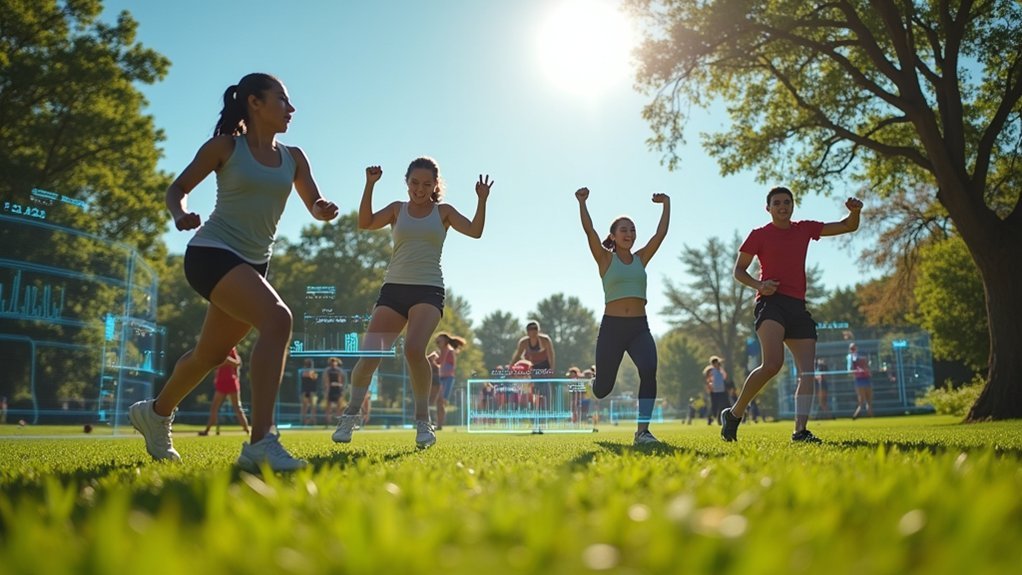NASA research reveals that 10 minutes of rebounding (trampoline exercise) equals the cardiovascular benefits of 30 minutes of running, with 68% greater effectiveness. You’ll experience improved calorie burning while protecting your joints from high-impact stress. The distributed gravitational stimuli strengthens muscles and bones while enhancing mitochondrial function and lymphatic circulation. This space-based science transforms how you can achieve ideal fitness in considerably less time. The benefits extend far beyond what traditional cardio offers.
NASA’s Surprising Discovery: Rebounding vs. Running Efficiency

When NASA scientists compared rebounding to running, they uncovered a game-changing insight for fitness enthusiasts everywhere. Their research revealed that just 10 minutes on a trampoline delivers the same cardiovascular benefits as 30 minutes of running.
The efficiency gap is striking—rebounding proved 68% more effective than treadmill running for calorie burn and aerobic conditioning. Each bounce generates increased G-force that rebounding supports by strengthening muscles and bones without putting pressure on your joints.
What’s most impressive is how this exercise delivers a high-impact workout effect with low strain on your body. By measuring acceleration, oxygen consumption, and heart rate, NASA confirmed that rebounding engages multiple muscle groups simultaneously, enhancing your stamina while notably reducing injury risk compared to traditional running.
The Science Behind Gravitational Stimulus in Exercise
NASA’s efficiency findings stem from a fundamental force we experience every day: gravity. When you exercise, gravitational force does more than keep you grounded—it actively maintains your bone density and muscle mass through constant resistance.
The NASA Study revealed that in microgravity, astronauts lose up to 1% bone density monthly, demonstrating gravity’s vital role in physical health.
What makes rebounding exceptional is how each bounce creates multiple gravitational stimuli distributed evenly throughout your body. Unlike running, which concentrates impact on specific joints, rebounding generates beneficial G-force with minimal stress.
This gravitational stimulus enhances mitochondrial function and cellular energy production, making rebounding 68% more effective than jogging for cardiovascular benefits. You’re not just exercising—you’re harnessing fundamental physics for peak fitness.
How Rebounding Creates Lower Joint Impact With Higher Results

Although traditional high-impact exercises often lead to joint strain, rebounding defies this pattern by distributing impact forces evenly throughout your body. This unique mechanism allows you to experience cardiovascular benefits with considerably less stress on your knees, ankles, and spine.
NASA’s research confirms you’ll achieve the same heart-healthy results in just 10 minutes of rebounding as you’d from 30 minutes of running. Each bounce generates a beneficial gravitational pull that builds bone density and muscle strength without targeting specific joints with excessive pressure.
You’ll find rebounding particularly valuable if you have joint concerns, as the rhythmic motion stimulates biological responses more effectively than running. This efficient workout engages multiple muscle groups simultaneously while maintaining low strain on your skeletal system.
Metabolic Advantages of Trampoline Workouts for Cardiovascular Health
Unlike conventional exercises that often demand high energy output for modest returns, trampoline workouts deliver remarkable metabolic efficiency for your cardiovascular system.
NASA discovered that just 10 minutes of rebounding equals 30 minutes of running benefits, making it a time-efficient cardio option that’s 68% more effective than jogging.
Rebounding provides exceptional cardiovascular stimulation with low strain on your body.
You’ll experience less fatigue and faster recovery while still achieving superior caloric burn and muscle engagement. This gravitational variation creates a unique stimulus that enhances both coordination and balance with each bounce.
Beyond heart health, trampoline exercise actively stimulates your immune system through lymphatic circulation—a benefit you won’t find in traditional running.
You’re literally bouncing your way to better overall health with less effort.
Applying Space Research to Everyday Fitness: Practical Applications

Space research findings have revolutionized how we approach everyday fitness routines. You can now leverage NASA’s discoveries by incorporating rebounding into your exercise regimen. Just 10 minutes on a mini-trampoline delivers cardiovascular benefits equivalent to 30 minutes of running, making it perfect for busy schedules.
| Activity | Efficiency | Joint Impact |
|---|---|---|
| Rebounding | 68% more effective | Minimal stress |
| Running | Less efficient | High impact |
| Walking | Least effective | Moderate impact |
Unlike traditional high-impact workouts, rebounding creates a gravitational stimulus that strengthens muscles and bones while protecting your joints. It’s ideal if you have joint concerns or simply prefer low-impact exercises. Regular sessions will improve your balance, coordination, and brain-body connection—all while burning more calories than treadmill running.
Frequently Asked Questions
What Is the Best Exercise According to NASA?
NASA considers rebounding (trampoline exercise) the best workout. You’ll get more benefits in less time—10 minutes of rebounding equals 30 minutes of running, and it’s 68% more effective while protecting your joints.
What Benefits Have We Seen From NASA?
You’ve seen incredible benefits from NASA’s research, including rebounding’s higher efficiency than running, better calorie-burning potential, reduced joint stress, and the knowledge that effective exercise doesn’t need to be uncomfortable to work well.
What Do 9 Months in Space Do to the Human Body?
After 9 months in space, you’ll experience significant muscle atrophy, lose about 9% of your bone density, face cardiovascular weakening, develop vision problems from fluid shifts, and may encounter cognitive challenges from isolation.
How Do Astronauts Regain Muscle Mass?
You’ll regain muscle mass through rigorous strength training and rebounding exercises after space travel. These targeted workouts counteract the atrophy from microgravity, while also helping restore bone density you’ve lost during your mission.
In Summary
NASA’s research offers you a clear fitness advantage: rebounding workouts deliver superior cardiovascular benefits with less joint stress than running. You’ll enhance your metabolic efficiency while experiencing stronger gravitational stimulus—just like astronauts in training. By incorporating trampoline exercises into your routine, you’re not just improving heart health; you’re applying cutting-edge space science to your everyday fitness journey. The results speak for themselves.




Leave a Reply